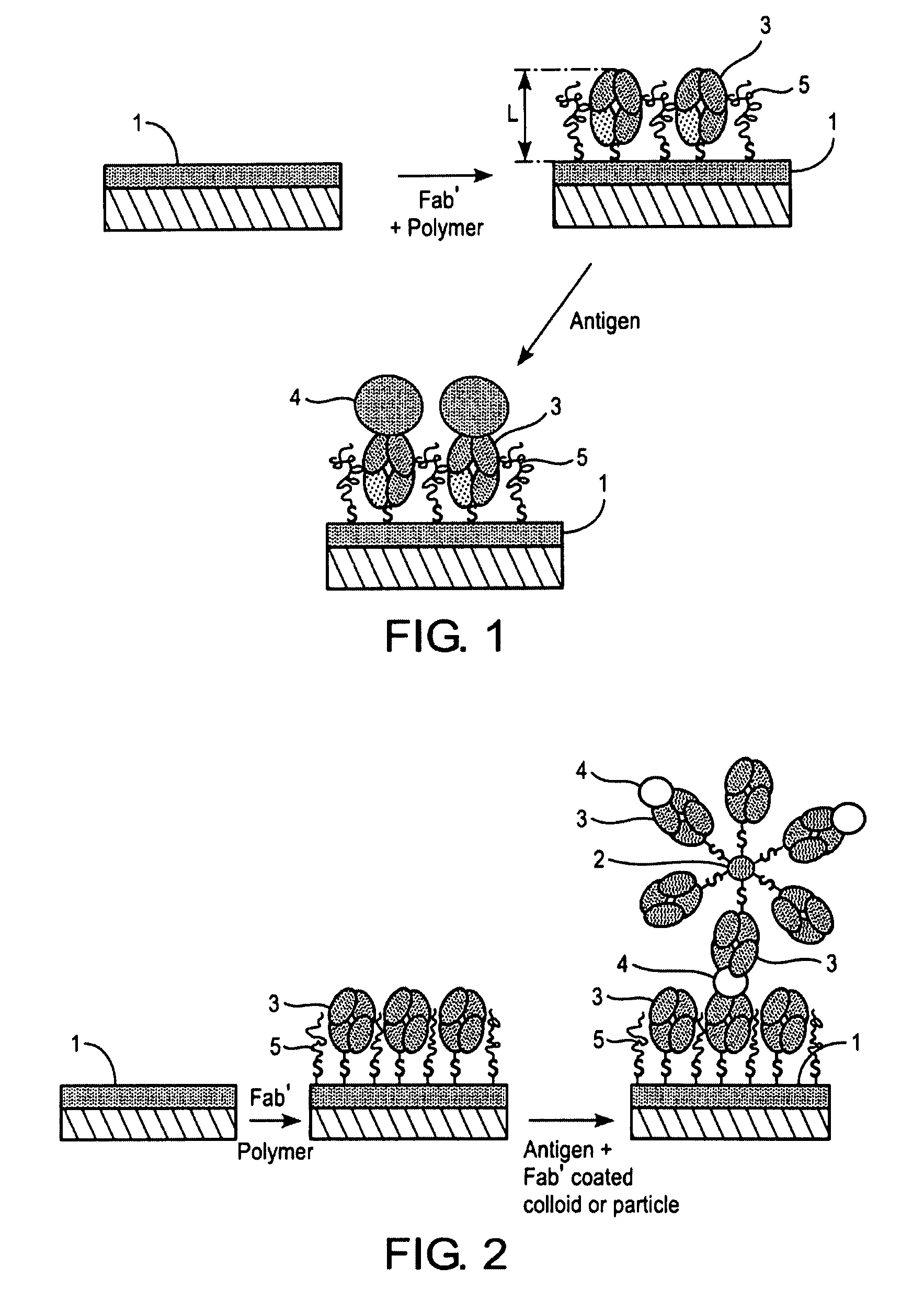Diagnostic methods
a technology of helicobacter pylori and diagnostic methods, which is applied in the field of new diagnostic methods for helicobacter pylori infection, can solve the problems of less suitable use for evaluation and follow-up of treatment and cure, relying on the detection of specific antibodies against i>h. pylori, and the relative long time needed for reliable test, etc., to achieve reliable detection of h and increase the sensitivity of the assay
- Summary
- Abstract
- Description
- Claims
- Application Information
AI Technical Summary
Benefits of technology
Problems solved by technology
Method used
Image
Examples
example 1
A General Procedure for the Preparation of the Carrier Substrate of the Invention
[0042]For the preparation of the carrier substrate, Fab′-fragments were first prepared from a specific monoclonal anti-H. pylori antibody as follows. First, F(ab′)2 fragments were prepared with ImmunoPure F(ab′)2 Preparation Kit (PIERCE, USA) from monoclonal anti-H. pylori antibodies, such as mono-clonal anti-H. pylori antibodies clones 7101 and 7102 (Medix Biotechnica, Kauniainen, Finland). Other known commercial kits and methods can equally be used. Then the F(ab′)2 fragments were split into Fab′ fragments with dithiothreitol (DTT, Merck) in a HEPES / EDTA buffer containing 150 mM NaCl, 10 mM HEPES, 5 mM EDTA, pH 6.0, typically over night in a microdialysis tube as described by Ishikawa [Ishikawa, E., J. Immunoassay 4 (1983) 209-320]. Briefly, F(ab′) 2 fragments at a concentration of 0.2-0.5 mg / ml were mixed with HEPES / EDTA buffer and 6.25 mM DTT solution in a microdialysis tube. The dialysis tube was i...
example 2
A General Procedure for the Measurement of H. pylori Antigens with SPR
[0045]H. pylori antigens can be measured in a biological sample with the following general SPR procedure. The surface of carrier substrate prepared as described in Example 1 is rinsed with PBS, pH 7.2. A negative sample (blank) is run at first. The negative sample used depends on the biological sample to be measured. Thus when, for example, a stool sample is to measured, the negative sample is a stool sample negative for H. pylori, when a urine sample is to be measured, the negative sample is a urine sample obtained from a subject without H. pylori infection, and when a serum sample is to be measured, the negative sample is a serum sample obtained from a subject without H. pylori infection. Then surface of the carrier substrate is sequentially brought into contact with the standard solutions, positive and negative controls and the samples by filling the flow cell of the measuring device for 10 minutes each with th...
example 3
Preparation of a Standard Curve and the Reproducibility of the Measurement
[0046]The H. pylori antigen, which was used as a standard, was extracted from the bacterial mass of H. pylori strain ATCC 49503 using the glycine-acid extraction procedure described by Rautelin and Kosunen [J. Clin. Microbiol. 25 (10) (1987) 1944-1951]. The protein concentration was determined with Bradford assay [Bradford, Anal. Biochem. 72 (1976) 248]. The standards were diluted in 0.1 M PBS, pH 7.2, to concentrations of 0.001, 0.01, 0.1, 1, 10, 100 and 270 μg / ml and run following the general procedure described in Example 2. Three separate measurements were made on consequent days to analyse the reproducibility.
[0047]The results are shown in FIG. 3A. The standard curve shown in FIG. 3A shows that the response is directly comparable with the antigen concentration on a semilogarithmic scale. Table 1 shows the standard deviations from three separate measurements of the standard curve on consequent days (FIG. 3...
PUM
| Property | Measurement | Unit |
|---|---|---|
| pH | aaaaa | aaaaa |
| pH | aaaaa | aaaaa |
| concentration | aaaaa | aaaaa |
Abstract
Description
Claims
Application Information
 Login to View More
Login to View More - R&D
- Intellectual Property
- Life Sciences
- Materials
- Tech Scout
- Unparalleled Data Quality
- Higher Quality Content
- 60% Fewer Hallucinations
Browse by: Latest US Patents, China's latest patents, Technical Efficacy Thesaurus, Application Domain, Technology Topic, Popular Technical Reports.
© 2025 PatSnap. All rights reserved.Legal|Privacy policy|Modern Slavery Act Transparency Statement|Sitemap|About US| Contact US: help@patsnap.com



